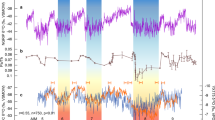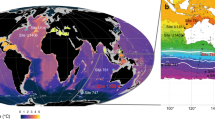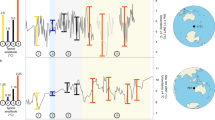Abstract
A period of continental ice growth between about 80,000 and 70,000 years ago was controlled by a decrease in summer insolation, and was among the four largest ice expansions of the past 250,000 years1. The moisture source for this ice sheet expansion, known as the Marine Isotope Stage (MIS) 5a/4 transition, has been proposed to be the warm subpolar and northern subtropical Atlantic Ocean1,2. However, the mechanism by which glaciers kept growing through three suborbital cooling events within this period, which were associated with iceberg discharge in the North Atlantic3,4 and cooling over Greenland5,6, is unclear. Here we reconstruct parallel records of sea surface and air temperatures from marine microfossil and pollen data, respectively, from two sediment cores collected within the northern subtropical gyre. The thermal gradient between the cold air and warmer sea increased throughout the MIS5a/4 transition, and was marked by three intervals of even more pronounced thermal gradients associated with the C20, C19 and C18’ cold events. We argue that the warm ocean surface along the western European margin provided a source of moisture that was transported, through northward-tracking storms, to feed ice sheets in colder Greenland, northern Europe and the Arctic.
This is a preview of subscription content, access via your institution
Access options
Subscribe to this journal
Receive 12 print issues and online access
$259.00 per year
only $21.58 per issue
Buy this article
- Purchase on Springer Link
- Instant access to full article PDF
Prices may be subject to local taxes which are calculated during checkout



Similar content being viewed by others
Change history
05 September 2013
In the version of this Letter originally published online, the 'Data' section of the Methods was missing. This is now correct.
References
Ruddiman, W. F. & McIntyre, A. Oceanic mechanisms for amplification of the 23,000-year ice-volume cycle. Science 212, 617–627 (1981).
Ruddiman, W. F. & McIntyre, A. Warmth of the subpolar North Atlantic Ocean during northern hemisphere ice-sheet growth. Science 204, 173–175 (1979).
McManus, J. F. et al. High-resolution climate records from the North Atlantic during the last interglacial. Nature 371, 326–329 (1994).
Chapman, M. R. & Shackleton, N. J. Global ice-volume fluctuations, North Atlantic ice-rafted events, and deep-ocean circulation changes between 130 and 70 ka. Geology 27, 795–798 (1999).
Dansgaard, W. et al. in Climate Processes and Climate Sensitivity (eds Hansen, J. E. & Takahashi, T.) 288–298 (American Geophysical Union, 1984).
Andersen, K. K. et al. The Greenland ice core chronology 2005, 15-42 ka. Part 1: Constructing the time scale. Quat. Sci. Rev. 25, 3246–3257 (2006).
Risebrobakken, B. et al. Inception of the Northern European ice sheet due to contrasting ocean and insolation forcing. Quat. Res. 67, 128–135 (2007).
Berger, A. Long-term variations of daily insolation and Quaternary climatic changes. J. Atmos. Sci. 35, 2362–2367 (1978).
Sánchez Goñi, M. F. et al. European climatic optimum and enhanced Greenland ice sheet melting during the last interglacial. Geology 40, 627–630 (2012).
Sanchez Goñi, M. F. et al. Contrasting impacts of Dansgaard-Oeschger events over a western European latitudinal transect modulated by orbital parameters. Quat. Sci. Rev. 27, 1136–1151 (2008).
Polunin, O. & Walters, M. A Guide to the Vegetation of Britain and Europe (Oxford Univ. Press, 1985).
Desprat, S. et al. in The Climate of Past Interglacials (eds Sirocko, F., Claussen, M., Sánchez Goñi, M. F. & Litt, T.) 375–386 (Elsevier, 2007).
Woillard, G. M. Grande pile peat bog: A continuous Pollen record for the last 140.000 years. Quat. Res. 9, 1–21 (1978).
Gouveia, C., Trigo, R. M., DaCamara, C. C., Libonati, R. & Pereira, J. M. C. The North Atlantic Oscillation and European vegetation dynamics. Int. J. Clim. 28, 1835–1847 (2008).
Oort, A. H. & Vander Haar, T. H. On the observed annual cycle in the ocean–atmosphere heat balance over the northern hemisphere. J. Phys. Ocean. 6, 781–800 (1976).
Sánchez Goñi, M. F. & Sirocko, in The Climate of Past Interglacials (eds Claussen, F., Sánchez Goñi, M. & Litt, M. F.) 197–205 (Elsevier, 2007).
Waelbroeck, C. et al. Sea-level and deep water temperature changes derived from benthic foraminifera isotopic records. Quat. Sci. Rev. 21, 295–305 (2002).
Fronval, T. & Jansen, E. Eemian and early Weichselian (140–60 ka) paleoceanography and paleoclimate in the Nordic seas with comparisons to Holocene conditions. Paleoceanography 12, 443–462 (1997).
Crucifix, M. & Loutre, M. F. Transient simulations over the last interglacial period (126-115 kyr BP): Feedback and forcing analysis. Clim. Dyn. 19, 417–433 (2002).
Chiang, J. C. H., Cheng, W. & Bitz, C. M. Fast teleconnections to the tropical Atlantic sector from Atlantic thermohaline adjustment. Geophys. Res. Lett. 35, L07704 (2008).
Binford, L. R. Constructing Frames of Reference: An Analytical Method for Theory Building Using Ethnographic and Environmental Data Sets (Univ. California Press, 2001).
Kucera, M., Rosell-Melé, A., Schneider, R., Waelbroeck, C. & Weinelt, M. Multiproxy approach for the reconstruction of the glacial ocean surface (MARGO). Quat. Sci. Rev. 24, 813–819 (2005).
Urbanek, S. & Iacus, S. M. R: A Language and Environment for Statistical Computing (R Foundation for Statistical Computing, 2007).
Oksanen, J., Kindt, R. & Legendre, P. et al. Vegan: Community Ecology Package. R package version 1. 8-8 (2007).
Pailler, D. & Bard, E. High frequency palaeoceanographic changes during the past 140,000 yr recorded by the organic matter in sediments of the Iberian margin. Palaeogeogr. Palaeoclimatol. Palaeoecol. 2799, 1–22 (2002).
Rosell-Melé, A. et al. Precision of the current methods to measure the alkenone proxy U37K′ and absolute alkenone abundance in sediments: Results of an interlaboratory comparison study. Geochem. Geophys. Geosyst. 2, 1046 (2001).
Prahl, F. G., Muehlhausen, L. A. & Zahnle, D. L. Further evaluation of long-chain alkenones as indicators of paleoceanographic conditions. Geochim. Cosmochim. Acta 52, 2303–2310 (1988).
Ahn, J. & Brook, E. J. Atmospheric CO2 and climate on millennial time scales during the last glacial period. Science 322, 83–85 (2008).
Landais, A. et al. A continuous record of temperature evolution over a whole sequence of Dansgaard-Oeschger during Marine Isotopic Stage 4 (76 to 62 kyr BP). Geophys. Res. Lett. 31, L22211 (2004).
Wolff, E. W., Chappellaz, J., Blunier, T., Rasmussen, S. O. & Svensson, A. C. Millennial-scale variability during the last glacial: The ice core record. Quat. Sci. Rev. 29, 2828–2838 (2010).
Acknowledgements
We thank the coring and logistic teams onboard the R/V Marion Dufresne during the IMAGES I, GINNA and ALIENOR oceanographic cruises. The work of M.F.S.G. and F.d. was supported by the ERC Advanced Grant TRACSYMBOLS no. 249587. IPEV, INSU-ECLIPSE and ANR-PICC French programmes provided financial support to UMR-CNRS 5805 EPOC as well as the RESOLuTION project funded by the ESF programme EUROCORES. A.L. received support from the ANR Citronnier. E.B. acknowledges financial support from the European Commission (Project Past4Future) and the Collège de France. We thank D. Urrego for assisting us with the statistical analysis, E. Salgueiro for reconstructing Iberian margin SSTs from core MD95-2042 using the Iberian margin database, and F. Rostek for measuring alkenones at CEREGE. We are grateful to S. Desprat, D. Urrego, M-N. Woillez, A-L. Daniau and W. Banks for constructive discussions, M-H. Castera, M. Georget and O. Ther for their technical assistance, and V. Hanquiez for drawing Fig. 1.
Author information
Authors and Affiliations
Contributions
M.F.S.G. designed the study, performed pollen analysis, interpreted the data and wrote the manuscript. E.B. provided the alkenone data and discussed data and interpretations. A.L. discussed the data. L.R. performed the foraminifera analysis and reconstructed sea surface temperatures. F.d. contributed to the writing of the manuscript.
Corresponding author
Ethics declarations
Competing interests
The authors declare no competing financial interests.
Supplementary information
Supplementary Information
Supplementary Information (PDF 1274 kb)
Rights and permissions
About this article
Cite this article
Sánchez Goñi, M., Bard, E., Landais, A. et al. Air–sea temperature decoupling in western Europe during the last interglacial–glacial transition. Nature Geosci 6, 837–841 (2013). https://doi.org/10.1038/ngeo1924
Received:
Accepted:
Published:
Issue Date:
DOI: https://doi.org/10.1038/ngeo1924
This article is cited by
-
Strong temperature gradients in the ice age North Atlantic Ocean revealed by plankton biogeography
Nature Geoscience (2023)
-
Flexibility within Quina lithic production systems and tool-use in Northern Italy: implications on Neanderthal behavior and ecology during early MIS 4
Archaeological and Anthropological Sciences (2022)
-
Reconstructing Late Pleistocene paleoclimate at the scale of human behavior: an example from the Neandertal occupation of La Ferrassie (France)
Scientific Reports (2021)
-
An ecological niche shift for Neanderthal populations in Western Europe 70,000 years ago
Scientific Reports (2021)
-
Heinrich Stadial aridity forced Mediterranean-wide glacier retreat in the last cold stage
Nature Geoscience (2021)



